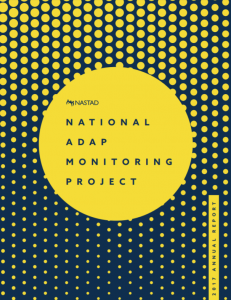 WASHINGTON, D.C. – Thursday, NASTAD released the 2017 National ADAP Monitoring Project Annual Report (The Report) and corresponding infographics. Since 1996, NASTAD has provided comprehensive information on AIDS Drug Assistance Programs (ADAPs) through The Report, which contains background information as well as detailed findings and corresponding charts and tables. All the resources related to the National ADAP Monitoring Project can be found on NASTAD’s website. In June 2017, The Report will also be available online in a digital format. This format will ensure The Report is accessible on both computer and mobile devices.
WASHINGTON, D.C. – Thursday, NASTAD released the 2017 National ADAP Monitoring Project Annual Report (The Report) and corresponding infographics. Since 1996, NASTAD has provided comprehensive information on AIDS Drug Assistance Programs (ADAPs) through The Report, which contains background information as well as detailed findings and corresponding charts and tables. All the resources related to the National ADAP Monitoring Project can be found on NASTAD’s website. In June 2017, The Report will also be available online in a digital format. This format will ensure The Report is accessible on both computer and mobile devices.
For the first time, The Report also includes key data related to the broader Ryan White Part B (RWPB) program and client services, including budget, expenditures, client utilization, and viral load suppression. This inclusion reflects ADAPs’ synergistic work with the broader RWPB program to ensure that the whole client’s needs are met.
Over the course of time, there have been significant shifts in funding and client needs; ADAPs have worked to meet those needs, however, have sometimes found themselves unable to serve all those in need of services. Lessons have been learned from these circumstances and ADAPs continue to look to identify how they can meet client need and ensure program sustainability. At a time now when ADAPs are documenting program stability, it is imperative that ADAPs look back on how challenges were resolved and look to the future of client needs and determine ways to prepare for the future. ADAPs are at an unprecedented juncture of being able to look to target resources to populations that need them most, to partner with the RWPB to ensure that the whole client’s needs are met, and to identify ways to bolster treatment for individuals’ health.
The Affordable Care Act (ACA)—and the dramatic expansion of access to Medicaid and insurance for millions of Americans—created opportunities for ADAPs to expand services. For example, over the past three years of full ACA implementation, ADAPs have increased their capacity to assist clients to purchase Qualified Health Plans (QHPs), providing vital premium and cost sharing support that have made plans affordable for clients. As a result, national ADAP enrollment has shifted dramatically and continues to trend toward greater numbers of insured clients in the program.
Yet the progress we have made through implementation of the ACA is very much in jeopardy. Two weeks ago, the House of Representatives passed the American Health Care Act (AHCA), a bill that repeals and replaces major pieces of the ACA and slashes the Medicaid program. The bill would strip health insurance coverage from 24 million people by 2026 according to the Congressional Budget Office score of an earlier version of the bill; the amended version that passed the House is likely to strip coverage from even more Americans. In addition to undercutting important consumer protections and affordability provisions for people living with pre-existing conditions, the bill would eliminate funding for the Medicaid expansion starting in 2020, moving us back to pre-ACA Medicaid eligibility rules that require individuals living with HIV and hepatitis to be disabled before they can get coverage. It would also cut $880 billion in federal support for Medicaid over the next ten years by moving the entire Medicaid program to a per capita cap funding structure. A reduction in federal support of this magnitude will force states to cut benefits, limit eligibility, and impose restrictions on services that will harm low-income people living with and at risk for HIV and hepatitis who rely on Medicaid.
“Cutting Medicaid will put far more pressure on safety net systems like ADAP and the Ryan White Program,” said Murray Penner, NASTAD Executive Director. “As the Senate takes up its own version of the AHCA, it is imperative that lawmakers understand the devastating impact that undercutting Medicaid and private insurance for people living with HIV and hepatitis will have on public health programs and efforts to fight end the epidemics.”











